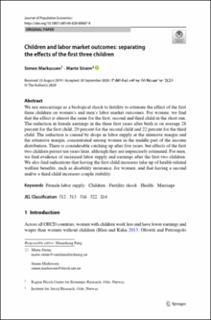| dc.contributor.author | Markussen, Simen | |
| dc.contributor.author | Strøm, Marte | |
| dc.date.accessioned | 2020-12-22T06:53:02Z | |
| dc.date.available | 2020-12-22T06:53:02Z | |
| dc.date.created | 2020-11-06T11:36:53Z | |
| dc.date.issued | 2020 | |
| dc.identifier.issn | 0933-1433 | |
| dc.identifier.uri | https://hdl.handle.net/11250/2720667 | |
| dc.description.abstract | We use miscarriage as a biological shock to fertility to estimate the effect of the first three children on women’s and men’s labor market outcomes. For women, we find that the effect is almost the same for the first, second and third child in the short run. The reduction in female earnings in the three first years after birth is on average 28 percent for the first child, 29 percent for the second child and 22 percent for the third child. The reduction is caused by drops in labor supply at the intensive margin and the extensive margin, concentrated among women in the middle part of the income distribution. There is considerable catching up after five years, but effects of the first two children persist ten years later, although they are imprecisely estimated. For men, we find evidence of increased labor supply and earnings after the first two children. We also find indications that having the first child increases take-up of health-related welfare benefits, such as disability insurance, for women, and that having a second and/or a third child increases couple stability. | |
| dc.language.iso | eng | |
| dc.subject | Barn | |
| dc.subject | Children | |
| dc.subject | Helse | |
| dc.subject | Health | |
| dc.subject | Arbeid og familie | |
| dc.subject | Work and Family | |
| dc.subject | Ekteskap | |
| dc.subject | Marriage | |
| dc.title | Children and labor market outcomes: separating the effects of the first three children | |
| dc.type | Peer reviewed | |
| dc.type | Journal article | |
| dc.description.version | publishedVersion | |
| dc.subject.nsi | VDP::Samfunnsøkonomi: 212 | |
| dc.subject.nsi | VDP::Economics: 212 | |
| dc.source.journal | Journal of Population Economics | |
| dc.identifier.doi | 10.1007/s00148-020-00807-0 | |
| dc.identifier.cristin | 1845570 | |
| dc.relation.project | Norges forskningsråd: 218378 | |
| dc.relation.project | Norges forskningsråd: 201416 | |
| dc.relation.project | Norges forskningsråd: 227103 | |
| cristin.ispublished | true | |
| cristin.fulltext | original | |
| cristin.qualitycode | 2 | |
